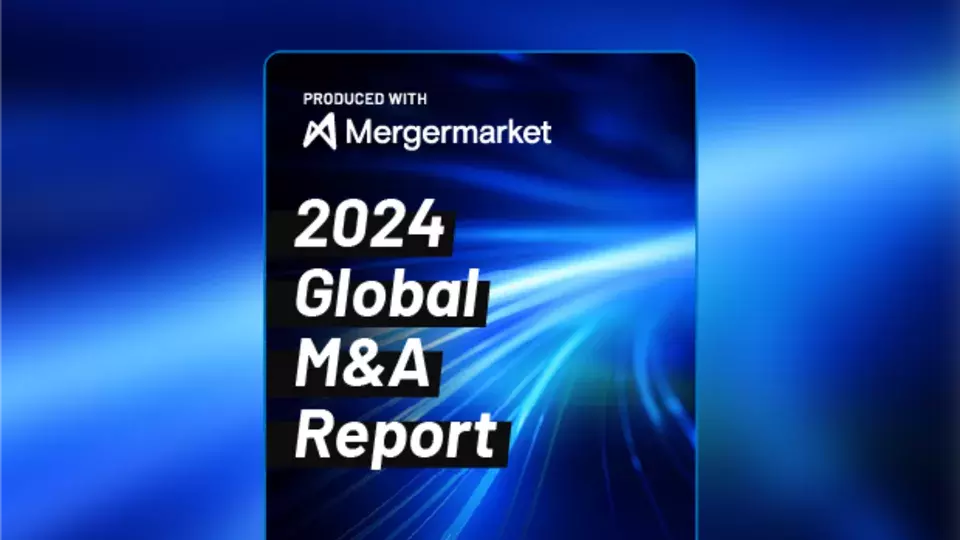Research Examines the Impact of Gender Diversity on M&A Deal Leaks
M&A leaks, whether intentional or not, impact deals, reputations and valuations. Today, we delve into the findings of an annual M&A leaks report by the M&A Research Centre at Bayes Business School (MARC) conducted for SS&C Intralinks. For the first time, this year’s study examines gender diversity's role in deal leaks at the executive and non-executive levels of public targets from 2008 to 2022. Dr. Valeriya Vitkova, senior research fellow and course director at MARC, joins us to discuss her research.
Dealcast is presented by Mergermarket and SS&C Intralinks.
****
Read a full interview with Dr. Vitova about her research examining the impact of gender diversity on deal leaks. here.
Dealmakers, are you ready for 2024? Read our new report, 9 M&A Dealmaking and Financing Trends in 2024, to understand the factors that will impact M&A and strategic financing in the next 12 months.
Transcript
Julie-Anna (00:05): Hello and welcome to Dealcast, the weekly M&A podcast presented to you by Mergermarket and SS&C Intralinks. I'm Julie-Anna Needham. I'm a business journalist who's been covering M&A for a decade. In this week's special episode, we are looking at the M&A Annual Leaks report. It's a study by the M&A Research Center at Bayes Business School for SS&C Intralinks. I'm pleased to welcome back to the podcast Dr. Valeriya Vitkova, who's a senior lecturer in corporate finance at Bayes, and a Director of Client Research at the M&A Research Center. She also wrote the report. Hi Val, thanks very much for joining me today.
Valeriya (00:50): Hi, very happy to be here.
Julie-Anna (00:52): So you've led the research for Intralinks annual deal leak study since its start now, this year's study is a little bit different from previous years because it looks at gender diversity when it comes to deal leaks. Can you begin by briefly explaining why this topic needs to be included?
Valeriya (01:10): So what we've seen is that there's a growing number of studies that show that higher levels of gender diversity, some more equal representation of men and women in the boardroom, can lead to more positive outcomes for companies. So for example, previous studies show that more gender-diverse boards are associated with, for example, less frequent and less severe securities fraud. There's fewer environmental sanctions, there's lower tax avoidance, and there's also lower rates of account misreporting and manipulation. And then the other aspect that motivated us relates to why having more gender-balanced boards and more gender-balanced senior leadership teams is good for companies. And there are three factors here. One is that prior evidence shows that gender diversity can help to improve the monitoring function of the board of directors. So that links, for example, to some fundamental functions such as there's better attendance of meetings or the quality of the discussions that take place can be better. Also, there is better monitoring of the disclosures and the reports that companies produce.
(02:52): And some studies show that women can be more risk averse and they can be less overconfident. And I think that's quite interesting. And one of the reasons why, as given as a rationale and explanation about these findings is that there's probably unequal levels of discipline being applied to male and female employees. So for example, studies show that female employees who are responsible for missteps or who make mistakes are subject to stricter penalties than their male counterparts. And I can give you some statistics here. One recent study that focuses on the financial services sector shows that following a case of misconduct, female advisors are 20 percent more likely to lose their job and 30 percent less likely to find a new job compared to the male counterparts. So these findings help us to understand why there might be this tendency that female board members and senior managers might be more risk-averse and less overconfident.
But then the other second area where greater diversity can be beneficial is that it can help to improve the expertise and skills in the boardroom. So that can help the functioning of the decision-making process. So for example, and this is supported by studies as well. So some studies show that more diverse management teams can be more innovative and creative, they can be more open to different ideas, and they can be more willing to consider alternative suggestions to various situations and problems that might arise. And this could be because when you have a better balance between male and female employees, then that allows for a greater variety of the educational and professional backgrounds. And then the third area where having greater gender diversity can help is linked to this idea that women might be more stakeholder-oriented.
(05:28): And here we can think about the fact that historically women have been taught different types of what is considered to be appropriate behaviors. And maybe there are certain personality characteristics that may typically be associated with women such as being more caring or compassionate or being more attentive to the needs of others. And in the corporate context, this can translate into greater attention to the needs of customers, employees, shareholders. And again, there is some evidence to support these ideas. And then what this boils down to is the fact that this can reduce the costs and increase the cash flows that companies generate. So one recent study that was actually produced by our school-based business school shows that it focuses on the banking sector and it shows that if you have a higher number of female directors that can translate into smaller size fines for misconduct and obviously lower frequency of misconduct. And so the cost savings that they estimated can amount to $8 million per year. So then coming back to our study, this is what motivated us because M&A leaks is a form of misconduct, is considered a form of market abuse that is subject to penalties by the regulatory bodies. And as far as we know, there aren't any prior studies that have addressed this topic. And so we thought that it would be a very, very interesting area to look into.
Julie-Anna (07:24): Val, that's all really interesting. So women are good for business. That's the crux of what you're saying. So the study that you've completed, so the study looking at leaks, how does gender diversity at board level relate to deal leaks for public targets between 2008 and 2022 last year? What are the key findings from your research into this?
Valeriya (07:51): So I think that one of the key findings that stands out from our analysis is that deals involving targets with more balanced gender-balanced boards are associated with the lower incidents of deal leagues. And here we find a stronger impact when we focus on gender diversity at the executive as opposed to the non-executive board member level. And the way that we rationalize this is that executive board members have more influence, more power, they are insiders, they go and work for the company on a daily basis, they have more information. And so that can have a greater impact. So we find, for example, that targets with more than 30 percent female executive board members experience approximately two percentage points, lower incidence of leagues. And we've also looked at combinations between levels of gender diversity at the non-executive and executive level. And what we find is that the lowest percentage of deal leaks takes place when you have 30 percent, at least 30 percent executive and at least 30 percent non-executive female board members. And, in fact, for those companies that have this kind of level of gender balance due leaks, the percentage of due leaks can be as low as three percent. So from 8.6 percent average, you can go down to three percent.
(09:30): And this is interesting because it relates to an important concept about critical mass. So there are studies that show that you do need to have a certain number of female executives to be able to achieve change and generate value. So if you have, for example, just one or two female executives who are there just to account for their social category, which is sometimes referred to as a token female director, then that doesn't really make a difference. In fact, it can destroy value. So I think that also is supported by our study and just a couple of other points. So what we find is that when you have greater gender diversity at the target board level, this can lead to for audio that are for those deals that are leaked, this can lead to lower completion rates and higher premiums being paid. And the way that I would explain this is that it's possible that when you have boards with more gender-diverse, more female representatives, they would be less willing to complete a transaction that is associated with a leak because of the negative connotations with market abuse and misconduct that surround these kinds of transactions actions. So I think these are the most interesting findings when it comes to our analysis of gender diversity and M&A leagues.
Julie-Anna (11:18): And can you talk about cause and effect and where that fits into the picture, please?
Valeriya (11:24): Yes. I think this is really important to address and we have to be a little bit critical here when we are looking at these results and admit that proving that something is a cause that results in an effect is typically challenging. So to say that more gender balance boards are the cause that leads to the result of lower frequency of dual leaks is difficult. And that is because of something that in academia we refer to as reverse causality, which means that it could be the case that female executives choose to work for companies that are less likely to engage in misconduct and fraudulent behavior in the first place. And we should also mention the fact that the number of M&A deals involving leaks is relatively small. As we say, it's about eight percent on an annual basis out of all of the announced transactions for public targets. So the sample size shrinks even further when we exclude companies for which we don't have information about the gender composition of the board of directors. And so the ability to examine trends or to make definitive conclusions about cause and effect is limited and we need to acknowledge this.
Julie-Anna (12:45): Okay, thank you. And so moving away from the gender-specific result and looking more broadly at the deal leaks report, the number of deal leaks were broadly the same in 2022 compared to the previous year, but there was a much higher value in those deals. Can you give us some of the headline findings from the report, please?
Valeriya (13:09): So globally, what we find is that M&A deal leaks in 2022 remain broadly at the same level as the year before. So we find that 8.6 percent of all deals announced involve the leak compared to 8.9 percent in the year before. And what we're seeing is that the level of deals has remained roughly the same between eight and 9 percent since 2009. And, in my opinion, this suggests that potentially the actions that regulators are taking to prevent dual leaks have not been fully effective since about 2009. But we need to acknowledge that some dual leaks are unintentional, so they are accidents or they happen by mistake stake. But, of course, it's unlikely that all M&A deal leaks are accidents and they all happen unintentionally. And we've conducted interviews in the past which actually also suggest that certainly some deal leaks are intentional. And then we should look at how this changes for a region, country, and industry because looking at the global picture can disguise some interesting differences at the regional country and industry levels.
Julie-Anna (14:39): Yeah. So can you run through the countries that have got the highest level of leaks, please?
Valeriya (14:44): So the rankings of the countries in terms of leaks can vary from one year to the next. And if we take the percentage of deal leaks over the period since 2009, we find that the weakest countries are Hong Kong, South Korea and India. And these kinds of differences in the number of leak deals, maybe of particular interest to regulatory bodies in these countries because this highlights the need for increased regulatory measures, market monitoring to help tackle these levels of misconduct. But we should also be aware of the fact that the number of deals involving public targets in some of these countries is relatively low, especially when we are looking at an annual frequency of leaks. So for example, out of the top three iest countries that we find for 2022, France had a relatively lower volumes of public target M&A transactions in 2022. So we need to be a little bit cautious when we consider these results. So what we're saying here is that some small changes in the number of deals can produce larger swings. So what I think is more important to focus on is the overall picture since 2009, where some countries have consistently been the weakest.
Julie-Anna (16:21): And let's look at the broader regional trends. While leaks decreased in Asia Pacific and Europe, Middle East and Africa, the Americas was a different story with a significant increase in that region. What's your thesis on the significant rise in deal leaks in the Americas
Valeriya (16:39): In 2022, North America was the leading region globally in terms of M&A deals. And so the higher levels of DU activity mean that there's likely to be more competition for targets in these regions. And so when there is more excitement in the M&A markets, we tend to observe more deal leaks. This could also be due to how business is done or cultural factors in some of these markets, which is likely to lead to higher levels of leaks at the region and country level. It's also important to mention that these markets are subject to different rules and regulations, and it's the perceived threat of being caught in insider trading scandals that can impact the behavior of different market players. And so that's the key drivers. I think it's the excitement in terms of having greater M&A activity and competition and also potentially the perceived threats that you might be caught could potentially be lower in these regions.
Julie-Anna (18:02): Great, thank you. And I'd like to talk very briefly about sectors. The sector with the highest level of leaks was retail followed by TMT and then industrials and healthcare. Why are these sectors particularly retail, traditionally? So leaky?
Valeriya (18:16): So it's a similar story to the region story because in 2022 we had a record 20-year high M&A deal volumes experience in the retail sector. And the reasons for this higher deal activity are related, for example, to companies seeking to improve their ESG capabilities and performance through mergers and acquisitions. There's also been increased focus on developing sustainable supply chains. We have seen increased focus on healthy eating, increased focus on ethical work practices and the use of plant-based ingredients. So MLA can enable companies to quickly buy capabilities to improve the way that they operate. Technology has been another major driver of deal volumes. Companies looking to develop e-commerce capabilities, for example, with direct-to-customer channels.
Julie-Anna (19:27): So that's more about the number of deals in those sectors.
Valeriya (19:32): And then that's what drives the higher volumes of activity, which leads to this competition and excitement in the market, which could also result in potentially greater media coverage, sometimes even media hype. And then that can be a stimulating factor for companies to leak transactions.
Julie-Anna (19:56): And we are just going to have to with through the last questions because we are running out of time. So leak deals took a shorter time to complete compared to deals without a leak. What's the reason for that difference?
Valeriya (20:08): So from the buyer's perspective, it could be that faster time to complete helps because of the threat or presence of competing bids. From the target's point of view. Longer time to completion could mean that there is a longer due diligence process and this increases the chances that the buyer can discover red flags that result in the deal being abandoned. And so there could be advantages on both the target and the buyer side to leak the deal to speed up the process.
Julie-Anna (20:46): Yeah, that is one of the reasons why deals get leaked and also that higher premium that you mentioned earlier. Just to finish up, can you briefly outline what deal makers can learn from your research when they plan for 2024, how can they try to ensure that deals aren't leaked?
Valeriya (21:05): So I think one of the new messages coming from our research is linked to the gender diversity idea. So setting the tone right at the top, starting from the senior leadership team is important. So more gender-balanced boards can be more effective potentially in monitoring and dealing with M&A situations to reduce the likelihood that there are leaks. Other measures can include more careful drafting of non-disclosure agreements between a target buyer and other parties to the M&A process. So for example, you could adopt penalty closes or inclusion of lower advisor fee and lower purchase price closes in the transaction engagement agreements to help to have more kind of stringent consequences in the case of deal leaks. And I guess increasing the use of virtual data rooms, secure more secure communication channels, improved cybersecurity measures can also be very, very important.
Julie-Anna (22:26): Val, great to talk to you again. Thank you very much. That was Dr. Valeriya Vitkova of Bayes Business School. Thanks for listening to this week's special episode of Dealcast presented by Mergermarket and SS&C Intralinks. Please rate, review and follow the podcast. You'll find us on Apple Podcasts, Spotify or look out for your Mergermarket news alert. For more information, have a look at our show notes. Join us again next week.




